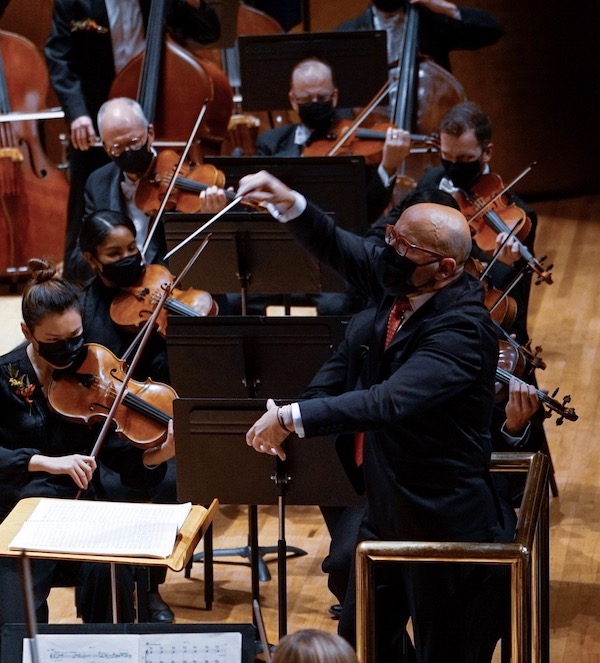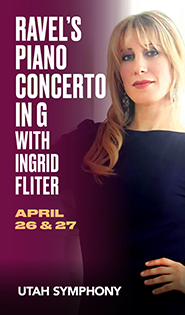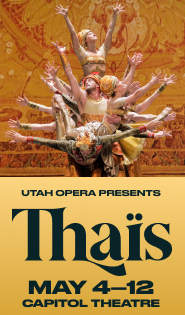Mazzola makes a fiery Utah Symphony debut
Abravanel Hall was only about half full Friday night for Italian conductor Enrique Mazzola’s Utah Symphony debut. But those who did attend experienced a delightful evening featuring one of the orchestra’s most communicative and polished guest conductors in recent memory.
The evening began with an expansive rendition of the Overture to Verdi’s La Forza del destino. Mazzola’s bio bills him as a specialist in early Verdi, but his interpretation of La Forza’s curtain-raiser showed a particular affinity for the composer’s late-middle period, when Verdi moved beyond traditions of Italian opera to write for international audiences. (La Forza was commissioned by the Imperial Theatre of St. Petersburg, Russia).
The piece is the quintessential operatic overture, providing a compact preview of the opera’s contrasting musical themes, and Mazzola mastered its many moods as well as the connective tissue between them.
Mazzola brought an intense fatalism to the piece’s opening, with conscientious phrasing and a clear melodic line. When the piece resolved from a minor to major key, the strings shimmered and swelled, plumbing the depths of Verdi’s gorgeous melodies. In addition to the strings, he gave shape and contrast to the brass, which were by turns courtly, ominous, and powerful. Mazzola’s movements on the podium were economical and controlled; with a simple wave he created dramatic shifts in the music’s character and volume. After experiencing the overture’s many contrasts, one was in the mood for the rest of the opera.
What followed instead was a ballet suite based on a film score, specifically, Nino Rota’s Suite del balleto La Strada, based on the Italian composer’s score for Frederico Fellini’s 1954 film, about a girl who is sold to a strong man in a traveling circus. Beginning with an irreverent circus theme, the score moves through moments of heartbreaking beauty, tempering moments of gushing sentimentality with a lucid sophistication and an impressive mastery of many musical languages. In addition to music evoking the circus, there are passages featuring jazz, blues, calypso, and syncopated Latin rhythms.
Here too Mazzola moved easily through the piece’s many styles, deftly swinging the jazz passages and nailing the syncopated rhythms. He brought out the character of the heroine, which was mostly represented by the strings, and the harshness of the world around her, present in the brass. The piece’s emotional climax was a plaintive, blues-inflected section for solo violin exquisitely played by Utah Symphony concertmaster Madeline Adkins. Rota’s work was a hit, with many audience members expressing disbelief at intermission that such an engaging piece had never been played by the Utah Symphony before.
The conductor’s next challenge was doing something interesting with a piece most had likely heard many times before— Brahms’ revered Symphony No. 4. That challenge was accentuated by the character of the Brahms’ piece, which, next to the fiery emotion of the Verdi and Rota, can sometimes come off as introverted, cerebral, and cold.
Mazzola met this challenge by focusing on what makes Brahms’ Fourth Symphony great: its sense of thematic development. Like his immediate predecessor, Beethoven, Brahms started with the smallest musical units, and used established forms to build them into a tightly constructed musical universe. Mazzola gave special attention to the two-note phrases that begin the piece, recur throughout all four movements, and form the piece’s underlying cell structure. He also carefully shaped the melodies that eventually formed, making sure they sang expressively in each section of the orchestra.
The foundational first movement had personality and life as well as a fatalistic foreboding quality. In the second, a stately Andante Moderato, Mazzola created a sort of fire and ice, with the strings warmly and passionately singing out the main theme and the woodwinds coldly and contemplatively working through the transition passages. He gave the third movement, a bright Allegro gracioso, a resolutely cheerful character, without abandoning the piece’s underlying fatalism.
The finale (Allegro energico e passionato) was marked by clear phrasing, communicative melodies, and an underlying sense of purpose. In the main theme, Brahms quotes a chaconne from a Bach cantata, and Mazzola allowed it to grow organically, guiding the orchestra to a sweetly singing climax. Rarely has the orchestra achieved such a glorious sound. The movement also featured expressive, lilting solo passages, including a standout solo by principal flutist, Mercedes Smith.
The performance brought the crowd to its feet for an extended ovation, and again, it would be nice to have seen more of them in the hall. There are several factors that could have contributed to the light attendance—area schools are on fall break and the Utah Jazz played its second home game of the season on the same night. There also may be a perception that soloists like Hilary Hahn, who nearly sold out the hall last month, are worth coming to see, but guest conductors are barely worth noticing.
After experiencing what Enrique Mazzola did with his Utah Symphony debut, here’s hoping that perception changes. And that the Italian conductor makes a return visit soon.
The program will be repeated 7:30 p.m. Saturday at Abravanel Hall. usuo.org.


